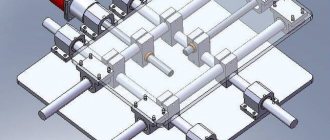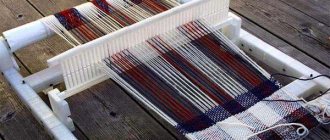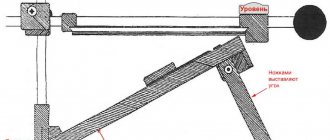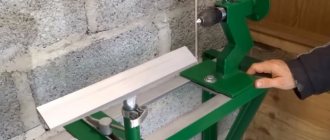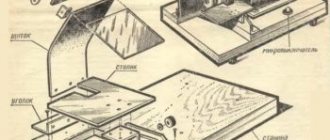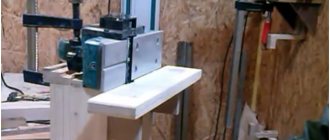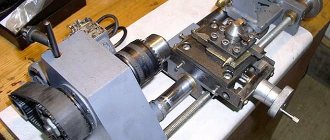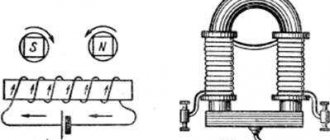Operating principle of surface grinding machines
The main difference between this type of equipment and electric emery is the degree of processing of the workpiece. It is intended not only for sharpening cutting parts, but also for removing a certain layer of material.
Structurally, the machine consists of a power unit (electric motor), which is located in the main body. With the help of transmission mechanisms (belt or gear), the grinding shaft rotates. To fix the workpiece, a frame is provided, which is most often connected to the body of the unit.
Depending on the design, metal processing units can be of the following types:
- spindle location – vertical or horizontal. This affects the processing technique of the part;
- accuracy of metal layer removal. This depends on the hardware settings. For factory models it is tenths of microns. In homemade installations, achieving such results is problematic;
- moving element. To process large workpieces, the position of the grinding part or the workpiece itself may change. In the latter case, a moving table is required.
One difference is the type of sandpaper used. Grinding wheels or an abrasive belt can be used for these purposes. In the latter case, the design must provide for the presence of two shafts with different diameters. This will increase the total processing area.
To make a surface grinding machine with your own hands, use circuits with manual parameter settings. Despite the relatively large errors, they are easy to implement for working on metal and wood.
Materials:
- washing machine motor;
- speed controller for electric motor;
- bearings;
- chipboard;
- threaded rod;
- mounting steel angle;
- a couple of pieces of polypropylene pipes with a diameter of 20 and 32 mm;
- screws, nuts, washers.
This machine uses an electric motor from a washing machine. We connect it to a 220 V network through the speed controller.
Diagram for connecting the regulator to the electric motor.
The body of the machine is made of chipboard and fastened with furniture screws. On the body, you need to bolt the engine. The support for the sanding tape is made from a mounting angle, the edges of which are rounded to prevent the tape lock from catching.
The drive roller is made from two polypropylene pipes with a diameter of 20 and 32 mm.
We select a large pipe with an internal diameter also equal to 20 mm.
Additionally, we insert a tin tube into the inner hole of the double pipe.
We put the drive roller on the splined shaft of the engine.
Now let's make the driven roller.
For the driven roller, we select two bearings and, depending on the outer diameter, a polypropylene pipe with exactly the same internal size.
We expand the bearings with a steel tube to relieve the lateral load. On the inner end of the roller we place a ring cut from a coupling of the same size, which will serve as a stop.
We assemble the resulting assembly on a hairpin and screw it to the base using washers and nuts.
The homemade grinding machine is almost ready, now we put on the sanding tape. When rotating, it can move along the rollers to the left or right. To prevent displacement, we rotate the driven roller around its axis using both nuts until the tape stops moving to one or the other edge. This way we will find the position where the tape is in place. Belt sander, ready to go!
A short video review of a homemade sanding machine.
Making a machine yourself
The main component of the equipment is the power unit. For this, it is best to use an asynchronous electric motor. The number of revolutions should be from 800 to 2000. But it all depends on the parameters of the workpiece.
The main problem is the absence of any diagrams for making a machine with your own hands. Experts recommend proceeding from the characteristics of the manufacturing materials that are at hand. The optimal household model is designed for processing small steel products. An abrasive tape is used for this.
Recommendations for making components yourself:
- main shaft It can be made of wood, usually the diameter is 25-30 cm;
- tension mechanism. Installed on the motor housing. Designed for belt tension, must have vertical adjustment;
- Desktop. The most important component that a surface grinder should have. Since changing the location of the motor shaft is problematic, the degree of impact of the abrasive on the workpiece can be adjusted by raising or lowering the work table.
The last component should include a steel plate and a flat part. Its position can be changed using adjustable legs. This is the best option for a homemade design.
To increase the processing area, you can install a shaft system. But you need to take into account that the dimensions of the entire unit will become larger.
For safety reasons, it is necessary to install a protective shield. It is made of plexiglass and attached using a regular loop. To ensure stability, a steel plate can be used as a base. The electric motor and work table are fixed to it. It is also recommended to install the on/off button in a convenient location for the operator.
To process parts made of carbide steels, corundum wheels can be used instead of an abrasive belt. They are installed on the motor shaft, the grinding procedure remains the same.
In the video you can see how a disc surface grinding machine was made with your own hands:
Making a surface grinding machine with your own hands
A surface grinding machine, which you can make yourself, is a very popular piece of equipment not only in manufacturing enterprises, but also in the home workshop. Such a device is practically indispensable in situations where it is necessary to grind and adjust metal parts. Of course, such work can be done manually, but this will take a lot of effort and time and will not allow achieving high precision processing.
Processing a workpiece on an industrial surface grinding machine
It makes sense to think about equipping your home workshop with a surface grinding machine if you often have to work on metal. In this case, you can choose one of two options: buy serial equipment or make such a machine yourself. The purchase of a serial machine is associated with serious financial costs, which is not always advisable for its use in a home workshop.
A homemade surface grinding machine will cost much less. Of course, the functionality of such equipment will be somewhat lower than that of serial equipment, but its capabilities will be quite sufficient to perform metal work at home.
Advantages and disadvantages
The advantages of grinding machines include:
- Quality and speed of processing.
- High performance.
- The ability to obtain the surface of the desired roughness.
- The ability to process not only the wood itself, but also pre-grind the finishing layer.
The disadvantages are:
- Release of a large amount of dust, requiring the organization of a dust removal system.
- Large quantities of consumables (abrasive) of several sizes.
- Difficult to manufacture and maintain (this especially applies to belt installations).
Considering the existing shortcomings, before starting assembly, you need to decide how necessary the machine is. If it will be used only occasionally, it is not practical to spend time on manufacturing - you can get by with hand tools.
How do surface grinding machines work?
The vast majority of parts made of metal undergo a technological operation such as grinding. To perform this with high efficiency and accuracy, surface grinding machines are used.
A rather difficult to manufacture banding machine with excellent functionality
Surface grinding machines of serial models can process both flat and profile parts. The surface processing accuracy that can be achieved using such devices is 0.16 microns. Of course, it is almost impossible to achieve such a result when processing on machines made by yourself. However, even the accuracy that homemade machines allow to obtain is quite sufficient for many metal products.
The load-bearing structural element of the machines of this group (as well as any other equipment) is the bed. Its dimensions directly determine what size parts can be processed on the machine. The most common material for manufacturing beds of surface grinding equipment is cast iron, since this metal, due to its characteristics, perfectly dampens vibrations, which is especially important for devices of this type.
Work table and controls of the 3G71M grinding machine
The structural element of surface grinding machines on which the workpiece is fixed is a work table having a round or rectangular shape. Its dimensions can vary significantly depending on the specific model of surface grinding equipment. The workpieces can be fixed on such a work table due to its magnetized surface or using special clamping elements. During processing, the work table makes reciprocating and circular movements.
In mass-produced surface grinding machines, the work tables are driven by a hydraulic system. In self-assembled equipment, mechanical transmissions are used for this.
Grinding a steel workpiece fixed on the working surface of the machine using a magnetic field
Important elements of the design of surface grinding equipment, which ensure the accuracy and smooth movement of the work table, are guides. In addition to high precision manufacturing, the guides must have exceptional strength, since in the process of almost constant movements of the desktop they are subject to active wear.
To achieve high processing accuracy, the guides must ensure accurate, smooth (without jerking) movement of the worktable with minimal friction of the contacting elements. That is why high-strength steel is used for the manufacture of these structural elements, which is hardened after the guides are made from it.
Option for manufacturing guides using angles and bearings
The working tool of a surface grinding machine, which can be a grinding wheel or an abrasive belt, is mounted on the spindle of the headstock. Rotation of the working tool, for which the main electric motor is responsible, can be transmitted through a gearbox or belt drive.
Homemade wood sanding machine - an example of a successful design
An old three-phase motor from a small ventilation station was used as the power plant. The advantage of this connection is that it is possible to organize reverse (in this case we are talking about the disk design of the machine). Sometimes, changing the direction of rotation of the sandpaper is necessary.
Connection using capacitors, the circuit has been discussed more than once on this resource. The working disk is cut from a plywood sandwich. Two sheets of 15 mm thickness are glued together with PVA glue, and then turned into a circle.
The entire bed, guides, and tool rest are made from the same 15 mm plywood. Since a homemade woodworking machine is made from wood (pardon the pun), additional attachments can be created. For example, a useful option for tilting the desktop.
Plywood was not chosen by chance. A powerful electric motor (especially for older people) is a source of parasitic vibrations. The wooden frame smoothes out vibrations that interfere with normal work. A stop device is installed on the hand rest for fixing horizontal angles.
Popular: How to make a homemade wood splitter with your own hands
Don't forget about work safety. On top of the rotating disk we attach an arch - a protective casing. This measure is not for aesthetics; touching the rotating disk can break your finger or seriously damage your skin.
Important! The surface of the tool rest must be sanded to perfect smoothness. The varnish coating is undesirable; it will wear off unevenly and the workpiece will be difficult to move.
Similarly, you can assemble a drum machine. It will be useful, for example, when preparing boards for flooring or a wooden table.
The main thing is the massive frame. The support bearings and wide drum are taken from a decommissioned conveyor belt, as is the motor.
The main task is to ensure an ideal horizon between the drum axis and the tabletop. The working surface is ground until final polishing. It is better to take harder material for the table.
Oak boards are too expensive, so you can use beech. A mandatory element of a drum sander is a table height adjuster. The screw mechanism must have a lock to prevent spontaneous unwinding due to vibration.
If the frame is not very heavy, you should secure the legs to the floor. Otherwise, the machine may overturn during work. When processing thick and uneven boards, the force applied is serious.
Conclusion: There is absolutely no need to spend your savings on purchasing industrial machines. All the designs considered can be made independently.
Recommendations for making a surface grinding machine with your own hands
Serial surface grinding machines, in addition to their high cost, are also distinguished by their large dimensions. Not every workshop can accommodate such a machine, which also limits their use at home. That is why many craftsmen prefer equipment made by themselves.
Many structural elements for making a surface grinding machine can be found in your workshop or garage, but some of them will still have to be purchased additionally. These are materials and devices such as:
- metal corners of two types - 50x50x5 and 25x20x1.5 (their total number will depend on the size of the machine you are going to make);
- pipes with a wall thickness of 2 mm or more, made of stainless steel;
- main electric motor, the shaft rotation speed of which is 1400–1500 rpm;
- a magnetic plate, the dimensions of which will also depend on the dimensions of the parts that you are going to process;
- 4 bearings and a set of ball screws;
- rail type guides;
- grinding wheel;
- end supports in the amount of 2 pcs.
Working surface of the machine with a homemade clamping device
Do-it-yourself manufacturing of a surface grinding machine begins with a frame, the frame of which is assembled from corners, cut to the required sizes and connected by welding. To increase the ability of the bed to absorb vibrations that occur during operation of the machine, a sheet of chipboard can be mounted into its lower part.
The next structural piece of equipment that will need to be manufactured is the work table, which uses a 4mm sheet of steel welded to the top of the frame. Rail guides are fixed on the surface of the finished desktop, which must be highly durable and manufactured accurately. Such guides can be purchased ready-made or ordered from a qualified milling machine operator.
Magnetic plate for grinding machine
A carriage will move along the worktable guides, on which a magnetic plate or a special clamping device is placed. The carriage is also made by hand from corners, which are cut to the required sizes and connected by welding. Wheels and ball screw elements are fixed to the carriage using screw connections. A screw with a handle, which will be responsible for moving the carriage, is installed in bearing supports, fixed at both edges of the desktop. Finally, a magnetic plate or clamping device must be fixed to the carriage.
Homemade surface grinding machine with an abrasive wheel as a working part
Homemade belt type grinding machine
The electric motor, on the shaft of which the grinding wheel is fixed, will move in the vertical direction using two guides. As the latter, you can use stainless steel pipes welded to the frame. The vertical movement of the metal plate base on which the electric motor will be fixed is communicated using ball screw elements.
One transmission support is fixed at the top of the guide pipes, and the second at the base itself. To ensure the rotation of the grinding wheels, you can use electric motors from old washing machines or vacuum cleaners. After the entire structure is assembled, you need to connect power to the motor, lubricate all the guides and perform a test run of your homemade surface grinding equipment.
Such a machine, if desired and necessary, can be modernized without problems by supplementing its design with devices that expand its functionality.
Construction of a homemade belt sanding machine
Grinding machine device.
The main parts of the machine are as follows:
- A motor or motor-driven engine powered by electricity. It is better to install the drive next to the main diameter drive roller.
- Base or bed. It is often fixed directly on the floor, sometimes this thing rides on wheels - whatever is more convenient and necessary for you.
- Two tension rollers - driving and driven. Make of metal or very durable wood with a thin layer of cushioning rubber to prevent the tape from slipping onto the rollers or drum.
- Spring and lever for the belt tension system. The spring is pressed, and the lever is attached to the base and driven roller.
- Base for placing a motor with a drive.
- For abrasive tape you need to use paper or cloth. Its width can be very different - in the range from 5 to 30 cm. Grit level - from 80.
- Metal pipes with a thickness of 2 mm or more.
- Metal corners in accordance with the dimensions of the machine.
- Special magnetic stand for metal parts.
- Rail type guides.
Diagram of the grinding machine.
Stages of work:
- We make the frame of the base or bed. – we cut the corners according to the dimensions of the bed; – weld the frame and corners; – we fix a chipboard board at the bottom of the frame to reduce vibration during operation.
- Making a work surface. – cut a steel sheet to size and weld it directly to the base; – weld the rail guides to the top of the frame; – we make a carriage from corners with wheels for moving along the guides of the bed; – on both sides of the working surface we mount and fix bearing supports; – fix the screw with the handle on the carriage;
- We fix the electric motor to the working area lifting system.
- We fix the gear supports.
- We install a tape with an abrasive coating. – cut the tape with a margin of a few centimeters at an angle of 45°; – glue it together overlapping with glue on the sides with the abrasive washed off with water; – dry the gluing area with a hairdryer;
- We are preparing for a test launch of the machine. – we treat all machine parts with machine oil; – supply electrical power; - We do a test run.
Tools
From time to time, every home craftsman needs to grind and adjust metal parts. This work can be done either manually or mechanically. The first option will require a lot of time and effort. The second greatly facilitates the grinding procedure and ensures good processing accuracy of the part. For mechanized processing of a part, you will need special equipment - a surface grinder. This is an invaluable item for metalworking.
If you regularly work with metal, then sooner or later there will be a need to purchase such a machine. There are two options: buy or try to assemble it yourself. The first option will cost a pretty penny and is advisable in cases where working on such a machine will bring in money, i.e. actually a business. The second option is cheaper. And although the capabilities and parameters of such equipment will be lower, nevertheless, its capabilities are quite sufficient for home needs. Since the topic of machine tool building is quite complex, this article does not claim to be comprehensive information. Rather, this is an attempt to understand the structure of a surface grinding machine and recommendations for those who decide to make such a machine with their own hands.
Content
Purpose and design of a surface grinding machine
Any metal part goes through a grinding stage. In industry, specialized machines are used for these purposes. They can be fully automated, i.e. CNC or semi-automatic. In everyday life, having such a machine is almost a luxury. This is true both in terms of the cost of such equipment and its capabilities. But since this article is about homemade surface grinding machines, it is simply necessary to know their structure. Otherwise, we would have to “reinvent the wheel.” Therefore, it is more advisable to consider a factory machine and copy its structure, adapting it to your needs.
So, a surface grinding machine is designed for processing profile and flat surfaces of parts. A professional machine is capable of providing surface processing accuracy of up to 0.16 microns. In everyday life, this figure, although desirable, is not critical, but in homemade machines it is practically unattainable. Unless you are a milling machine operator or lathe operator at an arms factory with 20 years of work experience.
The main component of any machine, and a surface grinding machine is no exception, is the bed. Its dimensions and strength will depend on the required characteristics (sizes) of the parts intended for processing. Factory machines have a cast frame, predominantly made of cast iron. Due to its massiveness, it excellently dampens vibration, and in grinding and finishing parts, this is practically the main condition.
The next part of such a machine is the work table. As a rule, this is a magnetic plate of a given size, but there are machines with special fastenings for parts. The main feature of surface grinding machines is the mobility of the table. It makes circular or reciprocating movements. The shape can be round or rectangular.
In factory machines, the table is driven by a hydraulic system. In a domestic environment, such a system will cost the owner quite a lot, so a reliable mechanical system will be sufficient.
The working surface of the surface grinding machine moves along guides. In professional equipment they have high precision and durability. For a home machine, these characteristics are also required. The maximum precision of surface processing of the part will depend on this. Also critically important is the smooth sliding of the table, without jerking. To achieve this, friction must be kept to a minimum. If this requirement is ignored, then when jerking the table with a fixed part, you can forget about grinding accuracy.
Disadvantages of my grinding machine
We recommend reading our other articles
- The practicality and benefits of purchasing corn seeds from a reliable and trusted supplier
- Wireless charging for iPhone - a stylish and practical solution
- Features of choosing household air conditioners
- Features and rules for choosing wires for arranging the power supply system
Practice has shown that the machine has the following disadvantages:
- When I got used to the machine, I realized that a 380 W motor was not enough, now I plan to convert the machine to a 1 kW motor. A machine with this engine allows you to sharpen wooden, plastic, and plywood blanks, but does not allow you to grind, for example, large boards and bars. Metal on this sharpening and grinding machine can be processed with a thickness of up to 2-3mm, a corner with a thickness of 4-5mm is already quite tedious to grind. It all depends on the goals, for me the machine performs 90% of the goals perfectly, but when I need to grind a large workpiece, there is not enough power...
- Sometimes the speed controller is missing, this can be solved by connecting a frequency converter.
- Rearranging a wheel with sandpaper takes about 5 minutes - you need to remove 2 casings and a table, and then unscrew the wheel with sandpaper - for some this is “5 minutes of work”, but for me it’s inconvenient when you need to sharpen something with finer sandpaper, but then work again with coarse sandpaper. For small jobs I use a universal machine with a drill chuck. Otherwise, it would be convenient to attach the emery to the circle with Velcro, or I’ll just make a second machine with a 1 kW motor for large jobs, and leave this one for smaller jobs.
- As I said above, replacing the sandpaper on a wheel is quite difficult - you need to tear off the old sandpaper, you can use heat or make a Velcro fastening. Although Velcro may have its drawbacks - I have not seen sandpaper for Velcro sold in our city - only small circles for a drill, and it can also fall off over time, because will become clogged with sawdust. And replacing the sandpaper on the wheel is not necessary so often - only once every few months.
- When processing wood there is a lot of dust, you need to connect a vacuum cleaner, so I started installing covers on the machine.
Surface grinding machine device
To construct sanding equipment for wood processing, you will need the following components and available tools:
- This mechanism forms the working surface on which the performing organ is mounted. The table can be mounted relative to the tabletop in any position, depending on technological needs.
- The machine is equipped with a drive, the purpose of which is to move the work table in the required direction.
- Above this table there is a working belt. Its location is determined by a screw mechanism.
- The grinding process is carried out using the transverse movement of the table and the possibility of longitudinal movement of the iron.
- The belt moves by an electric motor.
- The machine is also equipped with a dust collector, where waste generated after grinding is transported.
When setting technical characteristics for grinding, you need to proceed from the properties of the material being processed and its roughness. Thus, the following parameters are adjusted:
- speed;
- “roughness” of the working skin;
- the force with which the surface of the workpiece or semi-finished product must be pressed against the sandpaper.
The choice regarding the grain size of the skin is made based on the desired end result. The force used to adhere the belt and the speed are the fundamental indicators. If the belt is not pressed sufficiently and the speed of the grinding process is significant, then there is a possibility of fragmentary (incomplete) processing.
Principle of operation
The main difference between this type of mechanism and emery machines is the level of processing of the workpieces. It is suitable not only for sharpening cutting devices, but also for removing unnecessary layers of material.
Physically, the machine is equipped with a power mechanism (electric motor). Due to transmission elements (belt or gear drives), the grinding shaft rotates. To securely fix the workpieces, a base is provided, often attached to the mechanism body.
Depending on the design features, processing mechanisms can be of the following types:
- position of the working body - vertical or horizontal spindle. This directly affects the processing technique;
- accuracy when removing unnecessary layers. For production modifications this is tenths of a micron. In homemade machines, it is very difficult to obtain such parameters;
- mobile organ To process large parts, the location of the grinding element or the part itself can be changed. In the second case, there is a need to equip it with a moving table.
To make a surface grinder with your own hands, techniques with manual settings are used. Despite the rather significant errors, they are distinguished by ease of execution.
Types and features
Three modifications are offered for consideration, most applicable to home needs.
Surface grinder JET 16-32 Plus. This machine has excellent technical parameters, which are more than enough for household use and for minor repair work. The accuracy of surface finishing of a part can reach 10 fractions of a micron.
The machine consumes power at the level of 2 kilowatts, which is also acceptable for home working conditions, because not every electrical network can support the operation of a 10...15-kilowatt unit. Small dimensions and weight (61 kg). The characteristics of the main work are as follows:
Surface grinder PROMA RVR-400A. This is already the level of professional equipment, equipped with CNC. There is a working surface that is designed for a fairly significant load (350...380 kg), which will allow processing large-sized semi-finished products. The power of such a machine is 10 kW. Has the following operating parameters:
- 1100 mm – maximum possible longitudinal feed;
- 240 mm – possibility of cross feed;
- 550 mm – maximum lift of the “working body” above the bed.
This example is given more as an example, because equipment weighing almost 4 tons is needed in a production environment, and not in a home workshop.
Surface grinding mechanism LSh-322. The manufacturer of this equipment presents it as a machine for small repair rooms. Just what we need. The machine has small dimensions - 1050 × 1000 × 1800 mm, weight 700 kilograms. Significantly more compact than the previous model.
It has excellent characteristics regarding processing accuracy - maximum deviations are in the region of 3...5 microns, and roughness is 0.16 microns. Still, for household needs, this mechanism is expensive (its price is about $15,000) and also massive.
Video: homemade surface grinding machine.
Purpose and scope
Descriptions of the machine in question can be found quite often. It is used for grinding surfaces using the peripheral part of the wheel. It is possible to treat a surface that is located at right angles to the base. The characteristics can be significantly expanded if necessary.
The equipment in question allows for profile grinding. Technical characteristics determine that the method of threading the wheel profile affects the ability to process a particular shape, and also affects the accuracy of the resulting dimensions.
Often, the design of a surface grinding machine includes an electromagnetic plate, which is used to fasten the workpiece.
Key features that influence the scope of application are indicated in the data sheet. These include:
- The accuracy that can be achieved is class B.
- Roughness of the processed surface V 10.
Hydraulic diagram 3G71
The scope of application is very wide. You can often find it in large-scale production factories. The model is simple to operate; the control circuit allows precise control of the processing process.

